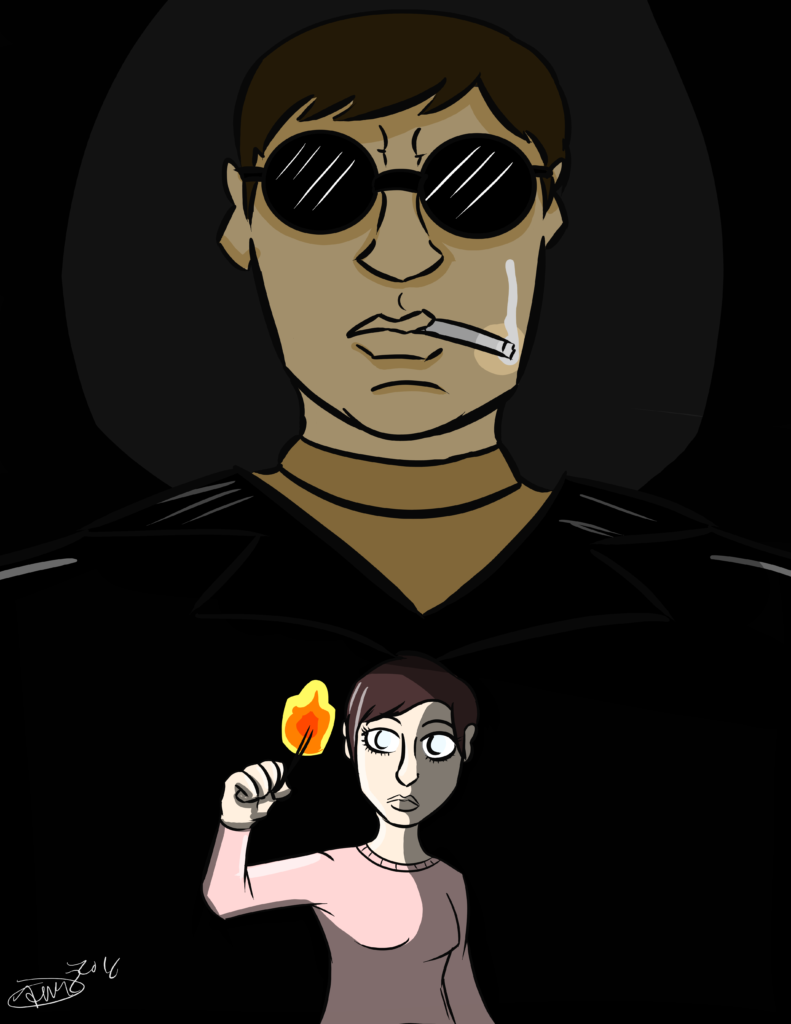
Original art by Andy Vanderbilt!
Due to the big success last week of the release of DON’T BREATHE, our topic for this week was a natural:
WHAT IS YOUR FAVORITE MOVIE WITH A DIFFERENTLY-ABLED PROTAGONIST (OR VILLAIN)?
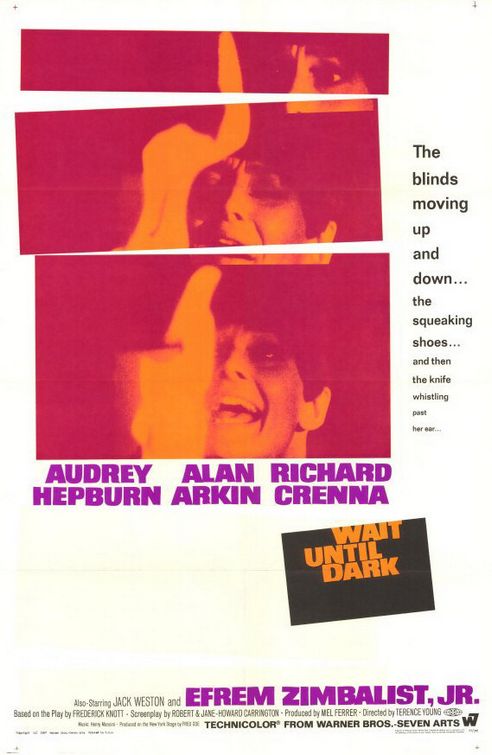
PATRICK SMITH: It’s an obvious answer, but I can’t not mention WAIT UNTIL DARK. For one, it shares a lot of basic DNA with DON’T BREATHE, but it holds up pretty well nearly half a century later. Back when I was considering going the acting route, a teacher told me that playing blind is one of the hardest roles for an actor, because it’s all about non-reaction until after the moment. Audrey Hepburn, an actress I can’t claim to have a deep familiarity with, pulls it all off as well as anyone could hope for. However, that performance is only possible thanks to Alan Arkin’s Roat.
Roat is a sociopath, but a sociopath with a flair for the dramatic. He puts a plan into motion to retrieve a doll filled with heroin that he believes Hepburn possesses, a plan that is so theatrical it seems like an indulgence. And it just might be, much like John Lithgow’s killer in BLOW OUT, who stages sex crimes as much as out of necessity as he does as not wanting to waste an opportunity for some fun. You get the feeling that Roat’s constant costume changes and characters are as much to keep him from getting bored as they are a functioning plan. It’s light fun that serves Arkins strengths, but also lures the audience into a false sense of security for the film’s climax, where Roat reveals just what kind of monster he is, and shows how sadistic you can be with little more than a silk scarf.
So that’s my pick, but if that one’s too heavy, there’s always SEE NO EVIL, HEAR NO EVIL.
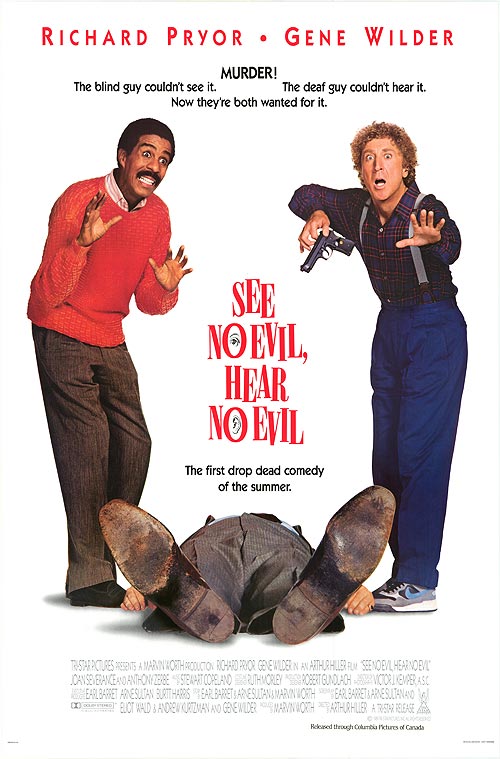
KEVIN MAHER: I’m betting a number of mainstream critics will call out WAIT UNTIL DARK, but I recently watched the Blu-Ray of THE IN-LAWS and Alan Arkin talked about how uncomfortable he was playing the heavy. He didn’t like being that guy for so many days. And he said it was so much worse terrorizing America’s sweetheart. Arkin could’ve had a career playing villains, but he decided he’d never play another heavy. (Aside from the evil Dean in BAD MEDICINE, of course.)

JOHN REENTS: There’s a serial killer at large in Robert Siodmak’s THE SPIRAL STAIRCASE, preying on “afflicted” women. The first victim had a scar on her face, the second was a “simple-minded creature,” and the third a woman with a pronounced limp. Dorothy McGuire, the top-billed star, plays a mute woman, and you can probably figure out the rest on your own.

McGuire gave one of her finest performances in THE SECRET STAIRCASE. Actors love playing disabled characters, but McGuire doesn’t give in to any mannerisms or quirks. She carries the film with an honest, nuanced performance, and it’s wonderful. She had some great support from Ethel Barrymore (who was Academy Award-nominated for her performance), Elsa Lanchester, Rhonda Fleming, and Kent Smith. There’s also some very effective camera work from DP Nicholas Musuraca, reminiscent of his work on Val Lewton’s horror films from the early 1940s.
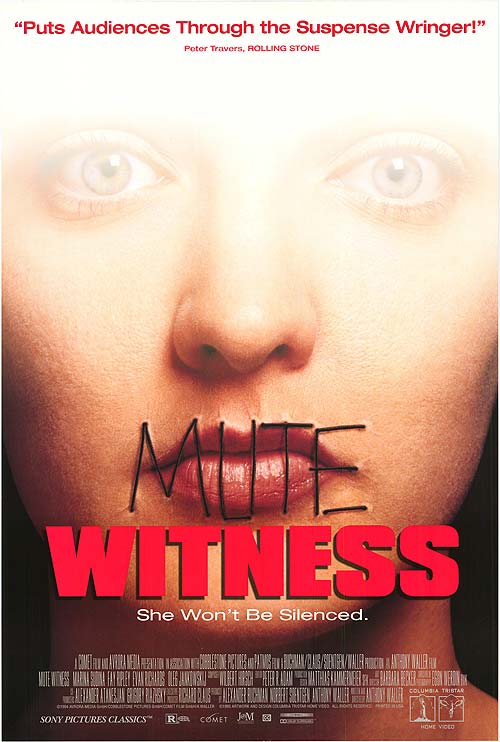
NATHAN SMITH: When I heard of DON’T BREATHE, Fede Alvarez’s acclaimed follow-up to his other acclaimed film, the EVIL DEAD remake, I immediately thought of MUTE WITNESS, a sort-of-sleazy picture about a vocally impaired effects artist working in Moscow on a low-budget slasher film. I’ll discuss as little as possible to preserve the way the film zigs and zags through its narrative.
1994’s MUTE WITNESS is a gem of a suspense film that unfortunately doesn’t get talked up as much these days. And that’s a shame, because it’s one of 1994’s best films. It was overshadowed by other, bigger independent films from that year, but it doesn’t mean it’s not as good. It was written and directed by Anthony Waller, who hasn’t done much more since, other than directing the pretty fun but lamented sequel AN AMERICAN WEREWOLF IN PARIS.
A fun fact about the film: Originally, the film was set to be shot in Chicago, but moved to Moscow to take advantage of a cheaper shoot. It actually works for the film, because it makes Moscow seem dark and scary and gives the audience of sense of auditory discombobulation when half the characters don’t speak English and other do. Having some characters speak non-subtitled Russian was a good directorial choice.
Waller shows real directorial prowess elsewhere in the way his camera prowls around the empty Moscow movie studio that our heroine finds herself trapped in after hours. The way he plays with sound design, camera angles, shadows, and Hitchcock dolly zooms, he really grinds the audience up into a fine dust of severed nerves and shocked looks over the course of a brisk 96 minutes.
It changes course about halfway through the movie and becomes a little silly, as we follow our lead, her sister and the director of the film as they stumble their way through a bizarre espionage thriller. It’s still fun throughout, replete with twists and turns and gratuitous violence and nudity. It grips everyone right up until the explosive end. It’s perfect for horror fans, and thriller fans alike. I’d honestly call it ‘Hitchcock style with DePalma sleaze.’ That’s the most apt description.
Funnily enough, the trailer is well-edited, using a minimalist scene to set the mood and sit audiences in their seats. But it uses a key bit of audio from the film-within-a-film to mislead the audience, and make them think that it’s about escaped maniacs, when it’s definitely not.
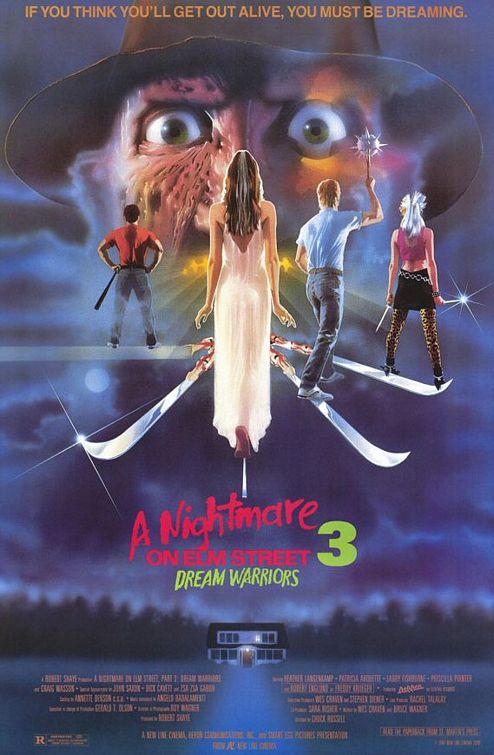
JEREMY LOWE: As far as movies with differently abled characters go, I think that NIGHTMARE ON ELM STREET 3: DREAM WARRIORS is one of the best. All the main characters are staying in an institution for teenagers with mental illness. Mental illness can be just as debilitating as any physical disability.
Besides suffering from mental illness, poor Joey was also mute. I thought that it was great that his “dream power” was that he got his voice back, and a sonic boom of a scream. The point where they go battle Freddy, and Freddy drags everybody except Joey into the mirrors — it really brought a smile to my face that Joey could save the day by shattering the mirrors with his sonic scream.
NIGHTMARE ON ELM STREET 3: DREAM WARRIORS is my favorite of the franchise. It’s gory, humorous, has a touch of fantasy, and best of all, it showed that some messed-up kids can be heroes.
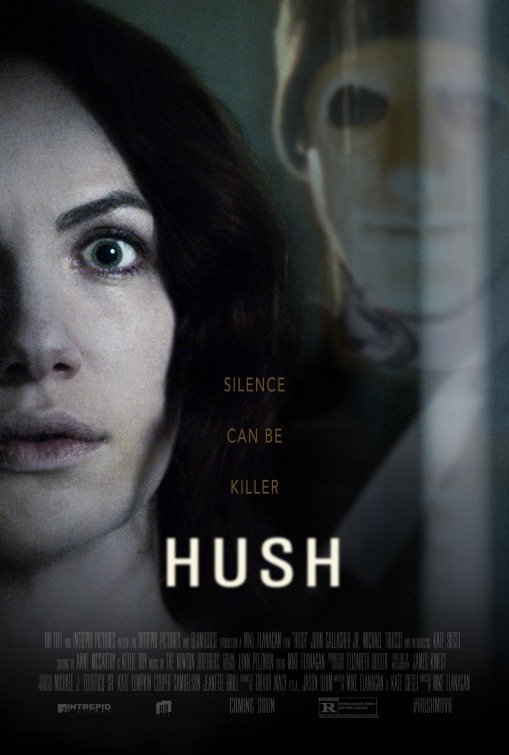
JON ZILLA: The calendar year 2016, such a diarrhetic monsoon in so many profound and awful ways, has inched towards redemption by providing a bumper crop of solid horror films. There have been so many good scary movies this year that I’m not even seeing much mention of HUSH anymore. That was this year too! It hit Netflix back in April, which feels like a lifetime ago already, but I’ve watched it twice now, which is twice more than I usually have time to do anything anymore.
Helps — a lot — that HUSH clocks at a svelte hour and twenty-one minutes. HUSH has a story to tell, HUSH tells the story, HUSH gets done with itself. It’s a classical work in that sense: so much horror is content to throw it back to the ’70s or ’80s, but aside from the technology and the potty language and the gore, this conceivably could have been made during the studio system. There’s no excess. This is a horror movie that’s nicely acted and efficiently directed, and that’s a result of how tightly it’s scripted — by its star and its director, not for nothing.
The lead character is deaf, and while the masked killer stalking her sees that as a weakness, her ‘disability’ turns out to be a virtues. As much as I dug YOU’RE NEXT, another movie about someone turning the tables on a home invasion, I cheered for HUSH that much more, because YOU’RE NEXT sort of crests with its reversal, whereas HUSH teases it out, makes it look like hope is lost (in an incredibly simple, visual, and poignant way: “I died fighting”), and then just as quickly, the reversal comes. And yes this is a movie that acknowledges victory comes with a cost — human beings died on the way to the bad guy getting what he deserved – and yes its smallest consolation in its final moment is literally perfect, and that’s coming from a dog guy.

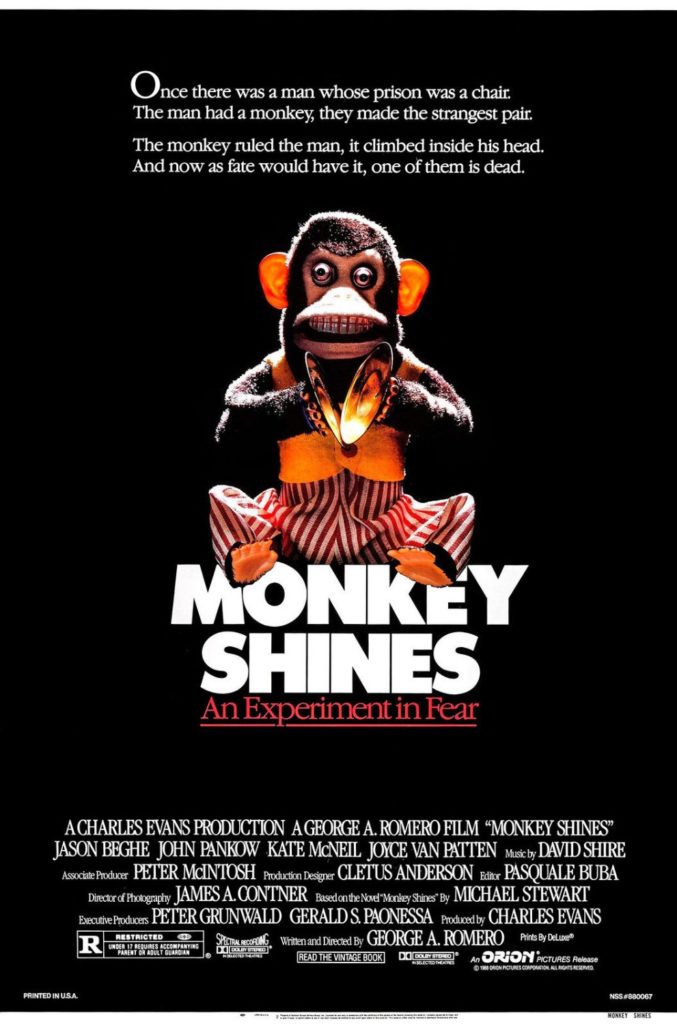
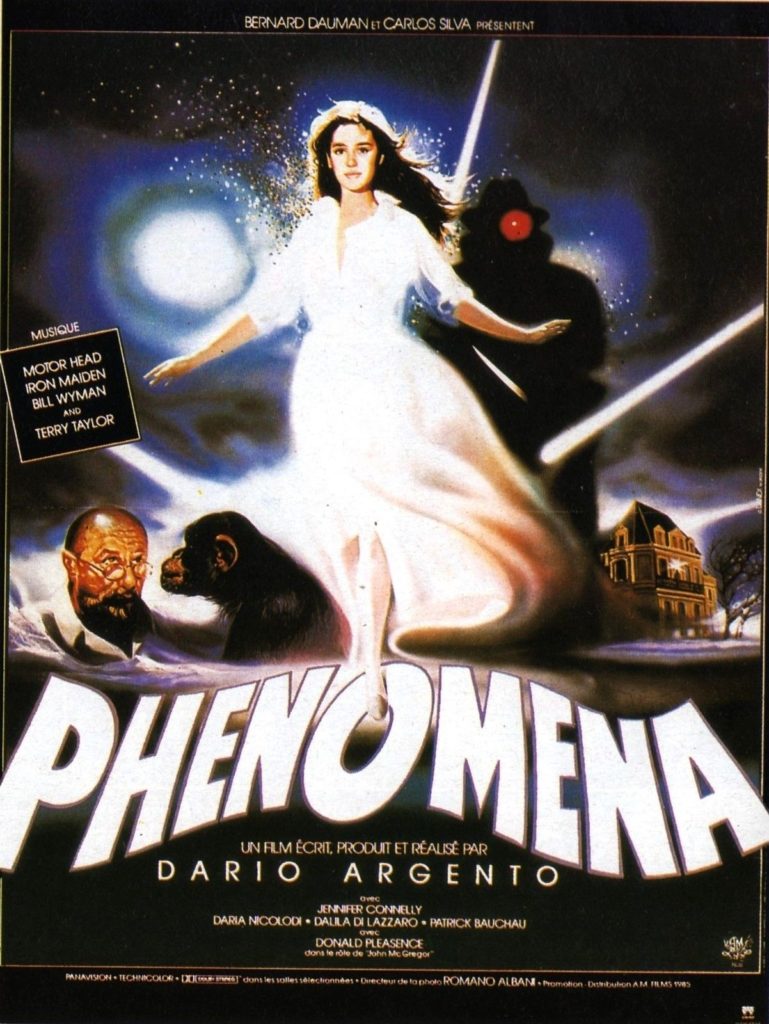
While I’m tempted to bring up SILVER BULLET and MONKEY SHINES too, maybe my all-time favorite in this genre is PHENOMENA — as if I haven’t talked about this movie enough — because here both heroes and villains have both limitations and special virtues. Aside from the heroine, Jennifer, whose ‘disability’ is normally more of a superpower — she can commune with bugs, but try telling a pre-teen girl at a boarding school in a foreign country, hoping to fit in, that she has a gift rather than a curse — there’s also Professor McGregor, her wheelchair-bound friend, with whom Jennifer bonds over a shared fascination with insects. And of course there’s Patua, the movie’s purported villain, whose facial deformity is really more of a reflection of his inner nastiness, although looked at another way, the poor guy never really had a shot. (His mother didn’t turn out to be such a nice lady after all.) Both McGregor and Patua represent crucial steps along the journey towards Jennifer finding a brief moment of peace at last, right before the movie ends.
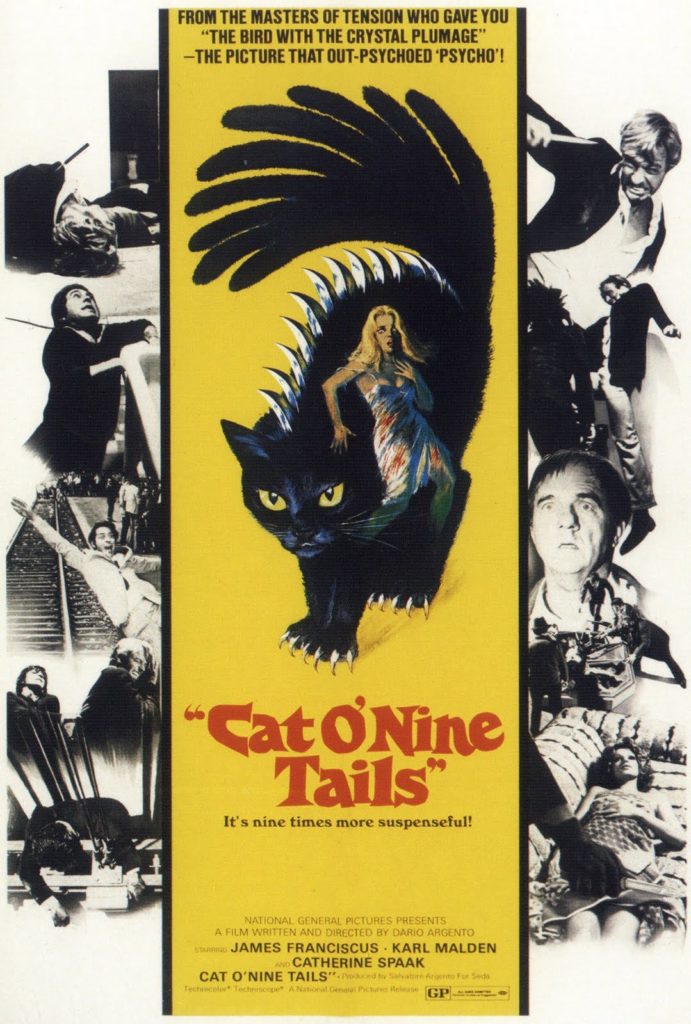
MATT WEDGE: THE CAT O’NINE TAILS (or IL GATTO A NOVE CODE, for you purists out there) is easily Dario Argento’s least flashy film. There are no grand setpieces leading to over-the-top gore (although there are quick moments of painful violence on display). The plot, while just as ridiculous as most giallo films before and after it, unfolds with something approaching logic. Even the casual sexism and homophobia often present in Argento’s early films is toned down to levels that only make me cringe a little. I suppose it is a small wonder that Argento once considered it the “least favorite” of his films. Despite Argento’s complaints that the movie felt “formulaic,” I find it an interesting anomaly in his career.
While blind crossword puzzle creator Franco Arnó (Karl Malden) is not exactly the protagonist of the film, he is the character constantly pushing the plot forward. His situation as a blind man is handled with a surprising amount of respect and humor for a movie from 1971. Arnó is far from helpless. A former newspaper reporter before losing his sight in an accident, he is resourceful, has a nose for bullshit, and a retractable blade in the end of his cane if anyone tries to take advantage of him. If anything, the danger he finds himself in as he helps a hard-charging young reporter (James Franciscus) investigate a series of murders is a result of his own hubris. Arnó brushes off any possible danger to himself or his family as impossible until it is too late, leading to a third act chase sequence that is both exciting and darker than expected as Argento upends the notion of the kindly old blind man who wouldn’t hurt a fly. But that’s what I like about the film; Arnó is never just a stereotype defined by his blindness. He is a fully realized human being who gets in over his head and has to live with the consequences.

- [THE BIG QUESTION] WHAT’S YOUR FAVORITE FEMALE ENSEMBLE IN MOVIES? - July 22, 2016
- [IN THEATERS NOW] THE BOY (2016) - January 24, 2016
- Cult Movie Mania Releases Lucio Fulci Limited Edition VHS Sets - January 5, 2016

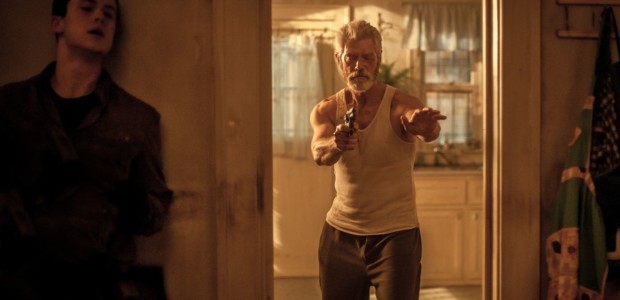




No Comments